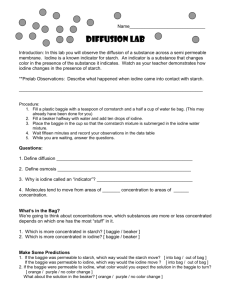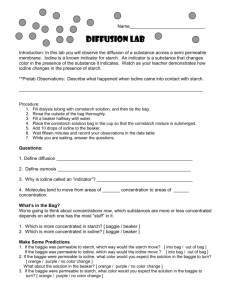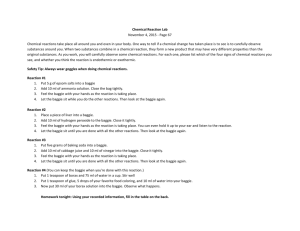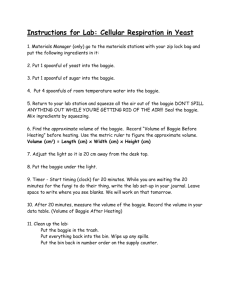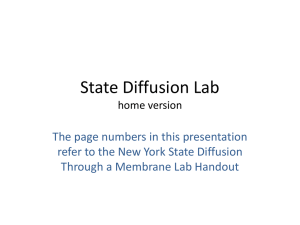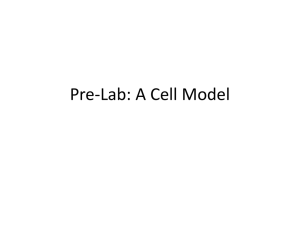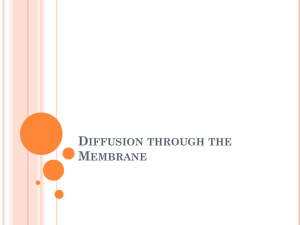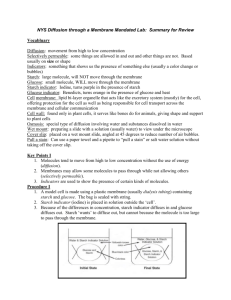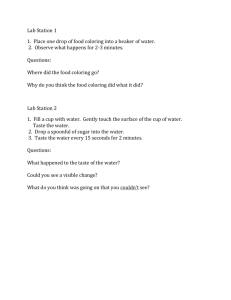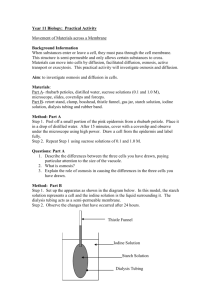Lesson Plan
advertisement
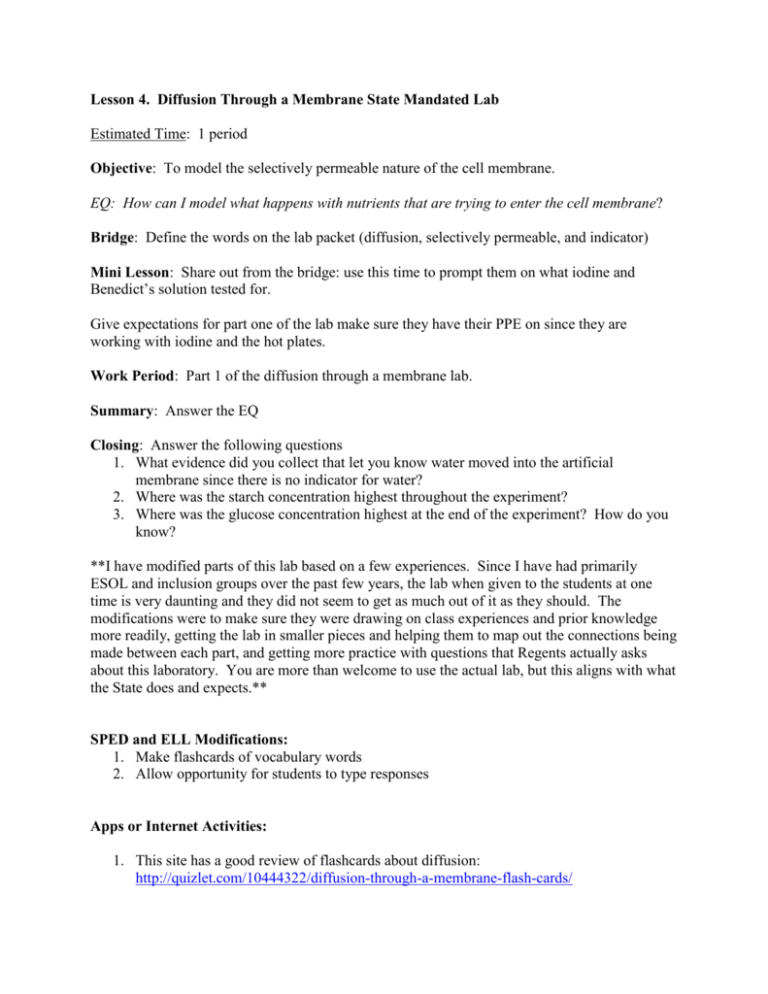
Lesson 4. Diffusion Through a Membrane State Mandated Lab Estimated Time: 1 period Objective: To model the selectively permeable nature of the cell membrane. EQ: How can I model what happens with nutrients that are trying to enter the cell membrane? Bridge: Define the words on the lab packet (diffusion, selectively permeable, and indicator) Mini Lesson: Share out from the bridge: use this time to prompt them on what iodine and Benedict’s solution tested for. Give expectations for part one of the lab make sure they have their PPE on since they are working with iodine and the hot plates. Work Period: Part 1 of the diffusion through a membrane lab. Summary: Answer the EQ Closing: Answer the following questions 1. What evidence did you collect that let you know water moved into the artificial membrane since there is no indicator for water? 2. Where was the starch concentration highest throughout the experiment? 3. Where was the glucose concentration highest at the end of the experiment? How do you know? **I have modified parts of this lab based on a few experiences. Since I have had primarily ESOL and inclusion groups over the past few years, the lab when given to the students at one time is very daunting and they did not seem to get as much out of it as they should. The modifications were to make sure they were drawing on class experiences and prior knowledge more readily, getting the lab in smaller pieces and helping them to map out the connections being made between each part, and getting more practice with questions that Regents actually asks about this laboratory. You are more than welcome to use the actual lab, but this aligns with what the State does and expects.** SPED and ELL Modifications: 1. Make flashcards of vocabulary words 2. Allow opportunity for students to type responses Apps or Internet Activities: 1. This site has a good review of flashcards about diffusion: http://quizlet.com/10444322/diffusion-through-a-membrane-flash-cards/ 2. This site is an interactive tutorial: Diffusion: http://www.wisc-online.com/objects/ViewObject.aspx?ID=AP1903 Diffusion and Osmosis: http://www.phschool.com/science/biology_place/labbench/lab1/intro.html 3. This is a game that moves molecules from one side of a membrane to another- however the ads are a bit graphic – thus would need to be a well monitored site. http://www.dailyfreegames.com/upload/adventure-games/diffusion-naren11-play.html Name ____________________________________ Living Environment School Date ___________________ NYS Mandated Lab: Diffusion Through A Membrane, Modified from its original form Part I. Diffusion and Selective Permeability Define the following terms: Diffusion: Selectively Permeable: Indicator: What is the difference between starch and glucose, since they are both carbohydrates? Question: Does the size of a molecule affect how it will move through the cell membrane? Prediction/Hypothesis: Lugol’s Iodine is an indicator for starch that turns a blue/black/purplish color. If the starch moves outside of the baggie, what would you expect to see? _________________ Benedict’s Solution is an indicator for glucose, but it only works when heated. It turns orange/red in color. If glucose moves out of the baggie, what would you expect to see once the solution is heated? _____________________________ Safety: Wear goggles and coats/aprons at all times (you should have gloves on as well but I do not have enough so please be very careful with the solutions. Iodine will stain skin and clothing and is corrosive, so if you spill some on yourself, wash your hands immediately). Experimental Design: Materials: string, cup, plastic fold over baggie or dialysis tubing, test tube, hot plate, glass beaker, water, glucose solution, starch solution, triple beam balance Procedure: In your plastic baggie, place 10 mL of starch solution and 10 mL of glucose solution. Tie off the end with the string as tight as you can. Tip it to make sure it is not leaking and rinse it off in your sink. Find the mass of the baggie. Record what you put into the baggie and what it looked like in your data section. In the cup provided to you, place the baggie and fill it with water up until the baggie is just barely covered. Add 10 drops of Lugol’s Iodine solution to the cup. Record what is in the cup and what it looked like in your data section. Wait for 20 minutes, recording changes that happen as you notice them in your data section. Record your final observations after the 20 minutes in the data section. Once you have completed this, take a pipette and draw off some of the solution outside of the baggie in the cup. Place it in your test tube and place your test tube in the hot water bath next to your table. Wait about 5 minutes and record your results. Data Beginning of the experiment: Using the key, record what was placed inside the baggie (dialysis tubing) and what is on the outside of the baggie at the start of the experiment. Key: G= glucose S= Starch W= water I= Iodine What did the inside of the baggie look like? _______________________ What did the solution outside of the baggie look like? ___________________ What was the original mass of the baggie with solution? ___________ (include unit) After 20 minutes: Using the key, record what was placed inside the baggie (dialysis tubing) and what is on the outside of the baggie at the start of the experiment. Key: G= glucose S= Starch W= water I= Iodine What did the inside of the baggie look like? _______________________ What did the solution outside of the baggie look like? ___________________ What was the final mass of the baggie with solution? ___________ (include unit) Analysis: Summarize what you found out in your experiment in your own words in the space below Evaluation: Once you have completed your evaluation piece, answer the following questions based on the lab. Glucose indicator was added to a beaker of an unknown liquid. Starch indicator was added to a different beaker containing the same unknown liquid. The color of the indicator solutions before they were added to the beakers and the color of the contents of the beakers after adding the indicator solution are recorded in the chart below. 1. Which carbohydrate is present in the unknown liquid? Support your answer. [1] _______________________________________________________________________ _______________________________________________________________________ A laboratory setup of a model cell is shown in the diagram below. 2. Which observation would most likely be made 24 hours later? (1) The contents of the model cell have changed color. (2) The diameter of the model cell has increased. (3) The model cell has become smaller. (4) The amount of distilled water in the beaker has increased. The diagram below represents the distribution of some molecules inside and outside of a cell over time. 3. Which factor prevented the protein molecules ( (1) temperature (2) pH (3) molecule size (4) molecule concentration ) from moving out of the cell? Base your answers to questions 4 and 5 on the information and table below and on your knowledge of biology. A model of a cell is prepared and placed in a beaker of fluid as shown in the diagram below. The letters A, B, and C represent substances in the initial experimental setup. The table below summarizes the content and appearance of the cell model and beaker after 20 minutes. 4. Complete the table below to summarize a change in location of substance C in the experimental setup. [3] 5. Identify substance B and explain why it did not move out of the model cell. [2] Substance: __________________________________________ _______________________________________________________________________ _______________________________________________________________________ 6. A solution containing both starch and glucose was placed inside the model cell represented below. The model cell was then placed in a beaker containing distilled water. Identify one specific substance that should have been added to the distilled water so that observations regarding movement of starch could be made. [1] _______________________________________________________________________
